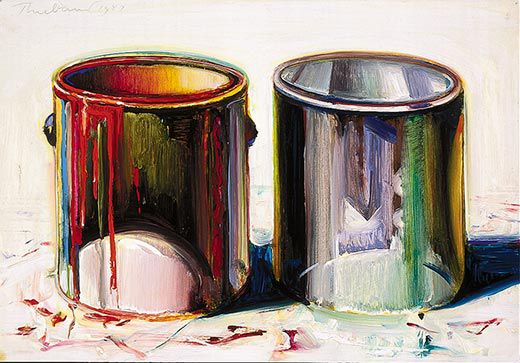Thiebaud, part 2

Two Paint Cans, Wayne Thiebaud
More Thiebaud, on how he isn’t and was never a Pop artist, is self-taught, and doesn’t trust art that’s rooted in ideas, from another book published in the same year as the one in the last post, Realists at Work, John Arthur, Watson-Guptill, New York, 1983:
You’ve described yourself as a self-taught painter. Does that mean you didn’t study painting?
No. I started as a sign painter and did fashion illustration, furniture drawing, lettering, and cartooning without going to school. At twenty-eight or twenty-nine, when I went back to college, I got credit for most art courses by special examination by that time I had exhibits, Army experience, and so on. I have courses on my record showing I studied painting and drawing, but those were generally by challenge; they just gave me grades. I took art history, courses like the psychology of art, lots of art education courses, but no formal training.
I believe I saw your rows of pies in Life magazine in the early sixties. Your work kept getting linked with Pop Art at that time, which I thought was a bit of a distortion. Much of Pop Art relied on the look of mechanical processes and played down the effect of the hand.
If anything, my interest was the opposite, more out of the tradition of Velazquez, Manet, to Eakins, through people like Jasper John and Richard Diebenkorn, for whom the signature gesture is central.
When I painted the first row of pies, I can remember sitting and laughing—sort of a silly relief—“Now I have flipped out!” The one thing that allowed me to do that was having been a cartoonist. I did one and thought, “That’s really crazy, but no one is going to look at these things anyway, so what the heck.”
Some people have talked about the irony in my work and the idea terrifies me. That’s something I’m not interested in on a conscious level, and the reason I’m not is because that kind of explication of an idea vitiates its power. If I were using what intelligence I have to be ironic, I couldn’t be smart enough for myself. I would be disappointed, and I’m generally disappointed in irony for that very reason. It seems self-explanatory and anticipatory in a way that never interests me. The reason I don’t like classical surrealism if there is such a thing, is that it seems already to have arrived before you’ve seen it. Even a good painter like Magritte—his ideas put me off.
You may be opposed to irony, Wayne, but not to wit.
No, I think wit is a very high form of attainment. Any kind of wit is one of the toughest things to do. Also, it’s one of the things that’s missing in so much of the art world. When you lose the capacity for a sense of humor in an art form, you lose a sense of perspective.
I was just talking to Harry Rand, who wrote a book on Gorky, about how, when you get so you can do something, you don’t want to do it anymore, and he said, “Yeah, that’s very hard, but I think one of the things that painters have to learn is that it’s all right once in a while to shoot fish in a barrel.”
Glad you refer to REALISTS AT WORK. I picked that book up in the mid-80s and still consider it one of my favorite art books. Sadly out of print.